|
ROBERTSBRIDGE to TENTERDEN 22 September 2012 |
|
Maps & Heights Walk to Bodiam Train to Tenterden Tenterden Station Tenterden Town Train to Bodiam Walk to R'bridge Poetic Finale Some Links Please Read Me |

Robertsbridge to Tenterden and Back
The Kent & East Sussex Railway (K&ESR) at present operates between Tenterden Town and Bodiam. However there is a reasonably good (usually hourly) mainline connection from London to Robertsbridge, from where the K&ESR originally started. It was a nice autumn day and I figured that it would be possible to get to, and back from, Robertsbridge from Essex in one day; at the same time it would also be possible to do a nice circular walk from Robertsbridge to Bodiam and back, and indeed, to combine this with a trip on the present full extent of the K&ESR. My plan worked well, albeit with a tight schedule, for I got back to Robertsbridge just as dusk was casting its cloak over what had turned out to be a very nice day - in terms of the weather and in terms of new impressions and experiences.
Bodiam Castle is a 14th-century moated castle. It formed a sort of "centre-piece" of my visit today.
The castle is conveniently close to the K&ESR's Bodiam Staion.
Please feel free to delve into the pictures and narrative which I have presented here. I hope you will find what you see here interesting. Indeed, it may perhaps encourage you to explore this part of the world, especially if this opportunity has not yet come your way. As so often on my other travels, I have tried to combine a good walk with the chance to learn a bit more about the many facets of our island on which we live. In this case, there was some some fascinating history from the Victorian era and indeed from even more distant times. Of course, the trip also gave me an excuse to practice a bit more the challenging art of photography. As you will see, I have arranged the presentation in chronological order. Enjoy your virtual visit!
- Maps & Heights
- Robertsbridge to Bodiam - On Foot
- Bodiam to Tenterden - by Train
- Tenterden - Station & Colonel Stephens Museum
- Tenterden - Town & Church
- Tenterden to Bodiam - by Train
- Bodiam to Robertsbridge - On Foot
- A Poetic Finale
- Here are some Further Links
- Contact, Copyright & "Readme"

Maps & Heights
As you will have already have gathered, my visit today was in two parts. It consisted of a circular walk centred on Robertsbridge, and a long stop-off point at Bodiam, to ride the Kent & East Sussex Railway and to visit Tenterden, part of the "Confederation of Cinque Ports". This section sets the scene and describes the general context, in terms of maps, heights and some interesting facts and figures. However, if you wish to speed on to the pictures and narrative, please click here.

Overview and Railway
The Kent & East Sussex Railway (K&ESR) was built to a budget by the indefatigable Colonel Holman Stephens, about whom more later. The railway was opened in 1900 from Robertsbridge, on the main line to Hastings, to Rolvenden (formerly called Tenterden) in 1900, and extended to Tenterden Town in 1903. It was extended in 1905 to Headcorn on the main line to Ashford. Tenterden had not, hitherto, been reached by any of the main railway companies, and the K&ESR was built to rectify this omission. The K&ESR was closed to passengers in 1954 and freight in 1961. In 1973, enthusiasts took over the section from Tenterden to Bodiam. The section between Bodiam and Robertsbridge is in the domain of the Rother Valley Railway who are actively pursuing the goal of providing the missing link between the K&ESR and the Hastings line. The completion of this link - hopefully in the next few years - is expected to enhance enormously the tourist potential of this Sussex-Kent border area.
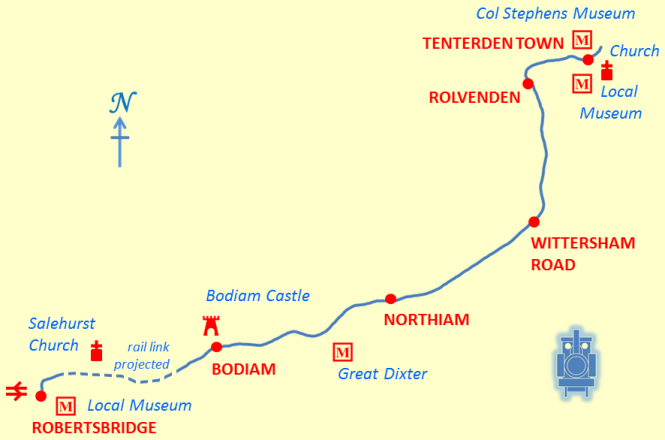
The Kent and East Sussex Railway (K&ESR) is presently open from Bodiam to Tenterden Town - a distance of about 10.5 miles. A substantial part of the "missing link" between Robertsbridge and Bodiam is already in the hands of the supporting Rother Valley Railway.
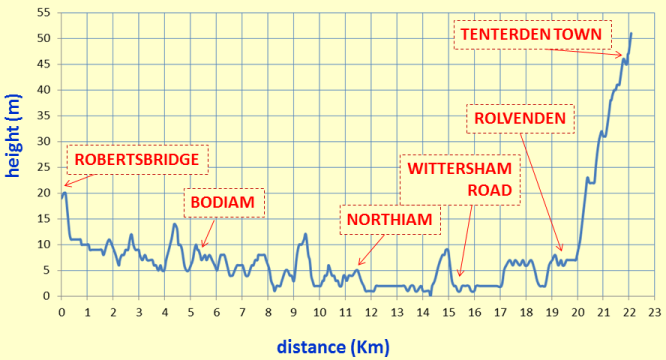
A great part of the railway operates close to sea level, following the Rother Valley. Tenterden - the present eastern terminus of the K&ESR - was, after all, associated with the Cinque Ports, indicating that the town originally had close access to the sea.
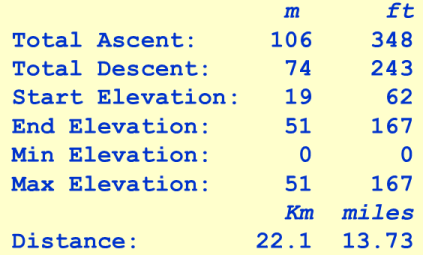
Distances and heights for the K&ESR. The section between Tenterden and Bodiam is open to visitors and is about 10.5 miles (16.8 Km) in length.

The Walk
The initial idea of the walk was to get to the Kent & East Sussex Railway, which is presently isolated from the rest of the rail network. However, with a circular distance of about nine miles, it was good exercise, both before and after my visit to the heritage railway. Of course, as walks so often do, it also enabled me to appreciate close at hand the countryside in this part of the world.
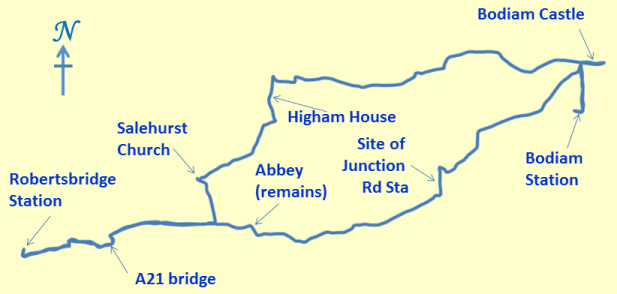
My "circular" walk of about 9 miles was in the anti-clockwise direction, with of, course a longer stop at Bodiam to explore the Kent & East Sussex Railway. The return "leg" took in Bodiam Castle and Salehurst church.
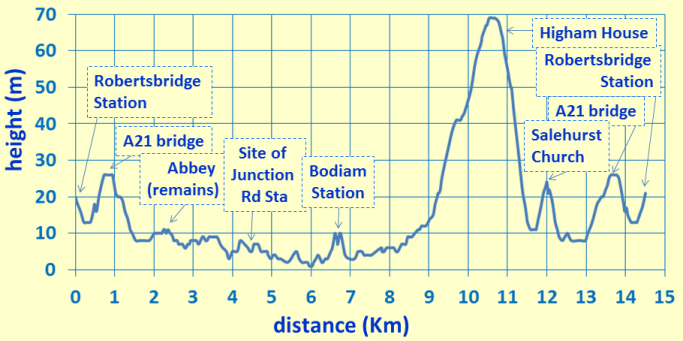
The land herebouts is, surprisingly, low-level. Heights on my walk ranged from close to sea level to just below 70 metres.
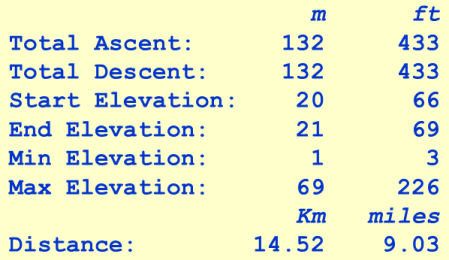
Here are some facts and figures pertaining to my walk. The terrain is not unduly taxing for most walkers, but the landscape is pleasant and interesting.

Robertsbridge to Bodiam - On Foot
My "circular" walk of about 9 miles was in the anti-clockwise direction, with of, course a longer stop at Bodiam to explore the Kent & East Sussex Railway. The start of the walk was of course in Robertsbridge, with its pleasant time-honoured buildings. The outward "leg" of the walk was the more direct part of the walk, passing the site of the old Salehurst Abbey, the site of the old Junction Road Station, and the western-most extremity of the the K&ESR in its present form. The return "leg" took in Bodiam Castle and Salehurst church before rejoining the first part of the walk through Robertsbridge for the final approach to Robertsbridge Station.
Parts of the walk were close to sea level, while the paths kept below 70 metres. Not unduly heavy going for most walkers, leaving time to enjoy the landscape.
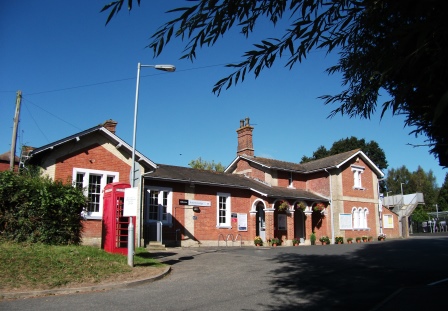
Robertsbridge Staion has retained its Victorian splendor. It was the starting point for my visit and might soon be an interchange for the line to Tenterden.

Nearby, the Ostrich pub proudly proclaims its presence with a nicely painted sign and a year that happens to be the year of the "Great Exhibition" in London.

In the centre of Robertsbridge, a half-timbered house nestles comfortably in the greenery.
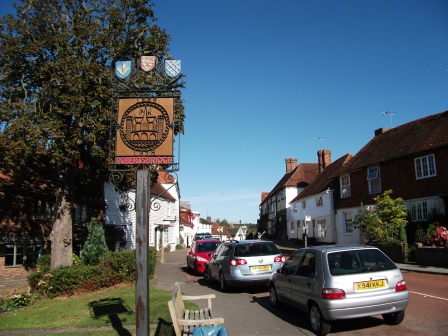
Closeby, the Robertsbridge village sign stands guard over one end of the high street, ...
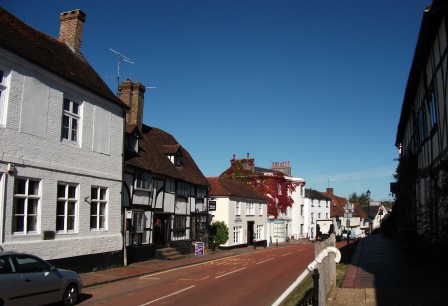
... with its traditional buildings.

There is a nice mixture of styles from ages past.

The High Street makes a gentle descent to the north.
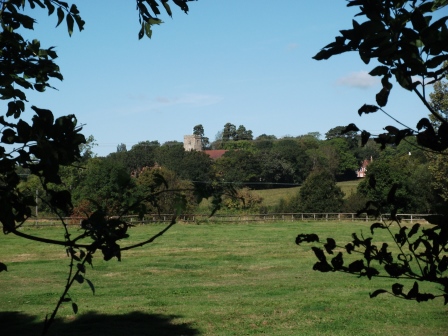
On the way to Bodiam, Salehurst comes into view. The fence marks the track of the railway, which, it is hoped will reopen in a few years' time. To the left is the site of the old Salehurst halt; the halt was originally put in at the request of the vicar of Salehurst for one of his flock.
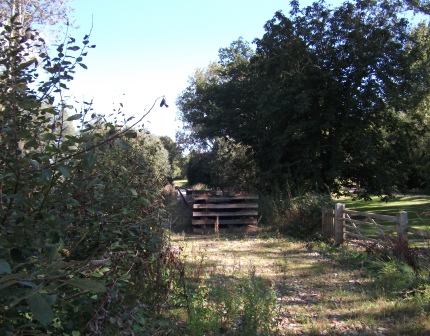
This is at present the western-most limit of the K&ESR track from Tenterden. It is also the site of the old Junction Road Station. The track between here and Bodiam Station actually belongs to the Rother Valley Railway, which is slowly but surely completing the gap between Bodiam and Robertsbridge.

Bodiam to Tenterden - by Train
It was a nice relaxing way to approach Tenterden, allowing me to soak up the wide open expanse of the landscape carved out by the River Rother over millenia, and at the some time, enjoying some railway history from a more recent era. Definitely to be recommended!
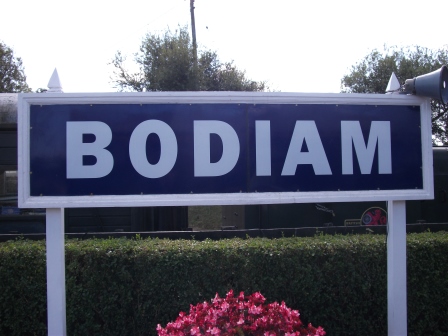
I eventually reach Bodiam Station ...

... and I have time to buy by return ticket to Tenterden and generally to have a nose around before the train arrives.
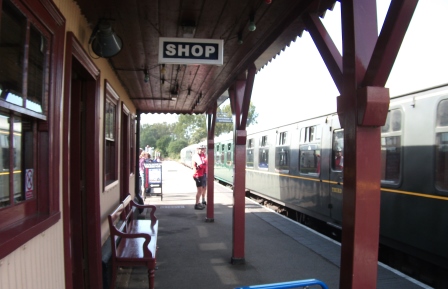
There are some passengers today, but it's a weekday.
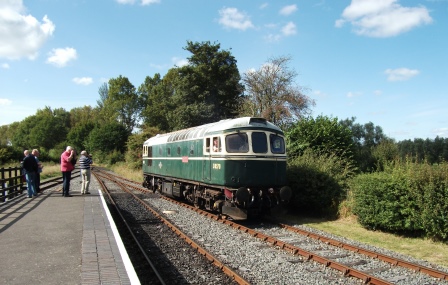
The class 33 diesel (vintage 1961) runs around its train ...
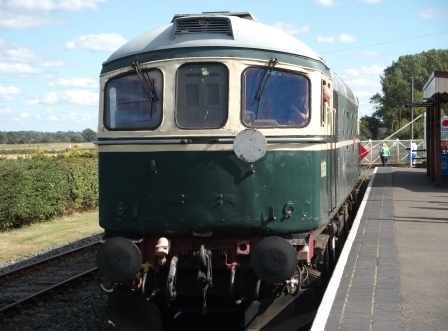
... backing on to the other end, ready for the return to Tenterden Town.
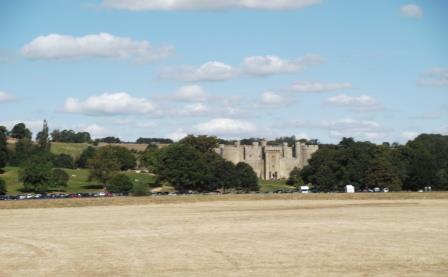
As the train heads out of Bodiam Station towards Tenterden Town, the broad-side expanse of the 14th century Bodiam Castle hoves into view. It actually has a sizeable moat, which a closer inspection - on foot - can stunningly reveal.
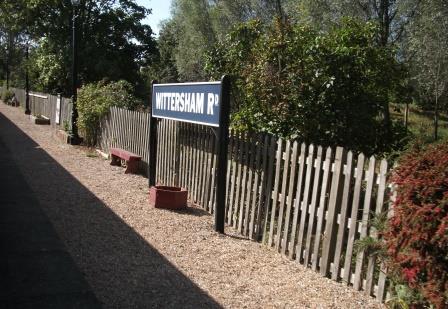
After Bodiam, comes Northiam and then it's Wittersham Road. The "Road" indicates that the village is a mile or two away from the station.
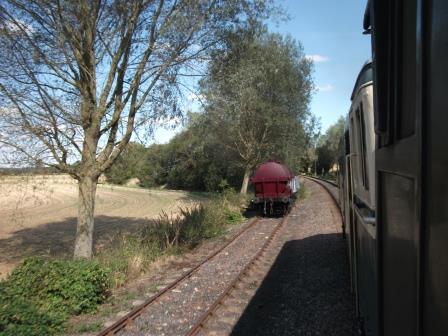
The train forges on through the Rother Valley, ...

... and then we reach Rolvenden Engine shed.
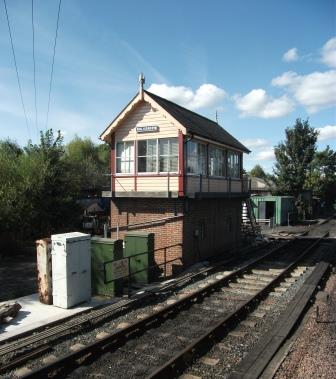
A signalbox to the south of Rolvenden Station controls the passing loop ...

... and a steam-hauled service is indeed passing, going back towards Bodiam. It hauled by No 23, a 1952 vintage saddle tank.
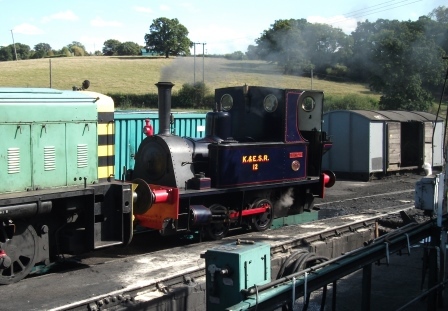
Outside the engine shed, "Marcia", a diminutive 0-4-0 tank engine of 1923 vintage is being steamed up, perhaps for test purposes.
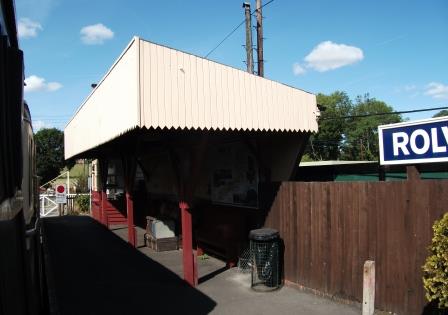
Rolvenden Station (the original Tenterden Station) has that "built-on-shoe-string" air about it.
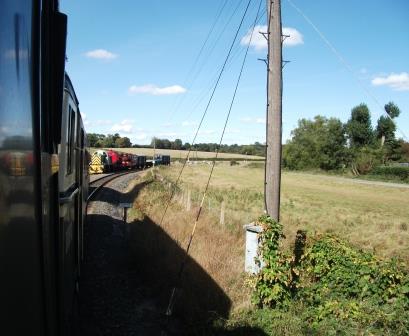
Then it's round the curve ...
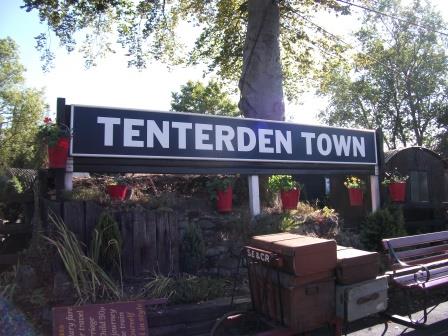
... into Tenterden Town Station, opened in 1903, three years after Rolvenden Station.
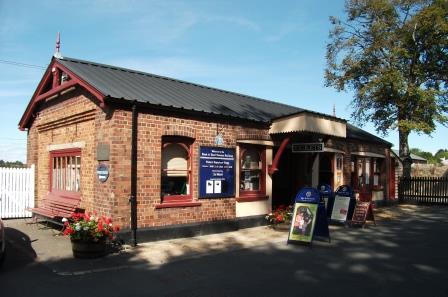
Indeed, the only really substantial brick building on the K&ESR is Tenterden Town Station itself, which houses the head-quarters of the line.

Tenterden - Station & Colonel Stephens Museum
A museum, dedicated to Colonel Stephens, the Victorian and Edwardian promoter of light railways, is housed in a listed corrugated iron building on the north side of Tenterden Station. The museum contains a number of interesting displays and artifacts. Outside, in the station area, some of the K&ESR's collection of splendid vintage and Pullman carriages can be seen.
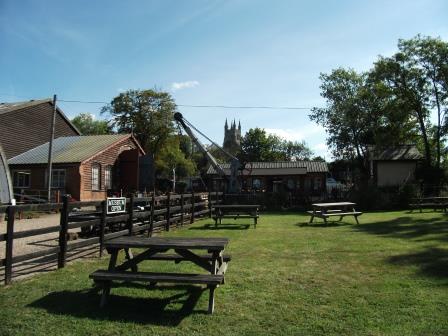
This is the picnic area to the north of Tenterden Town Station. Tenterden church is in the background. The museum devoted to Colonel Stephens, about whom more below, is in a listed - but not that beautiful - corrugated iron structure, the edge of which you can just discern on the left-hand edge of this picture.
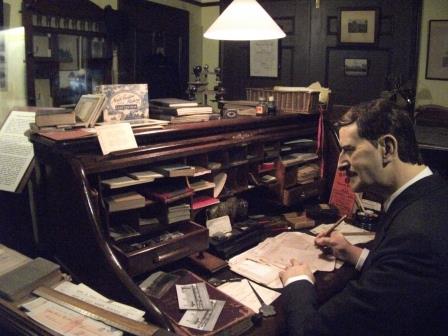
Colonel Holman Fred Stephens (1868 – 1931) was a Light Railway Promoter, Engineer and Manager. Indeed, he had quite a few light railways to his credit, including the Kent & East Sussex Railway and the Ffestiniog Railway. His aim was to bring the railway to those places - such as Tenterden Town - which the big railways had "passed by". Admittedly, most of his enterprises were not blessed with great financial success.
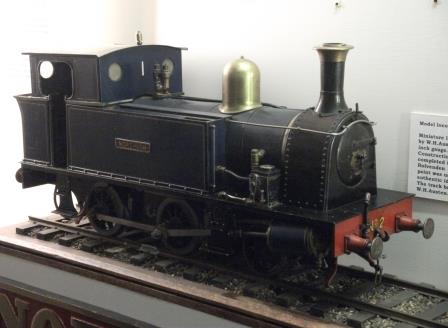
This is a model of "Northiam", built with sister engine "Tenterden" in 1899, ready for the opening in 1900 of the first part of the K&ESR. Both engines were scrapped in 1941, but not before "Northiam" had starred as "Gladstone" in 1937 in Will Hay's "Oh Mr Porter".
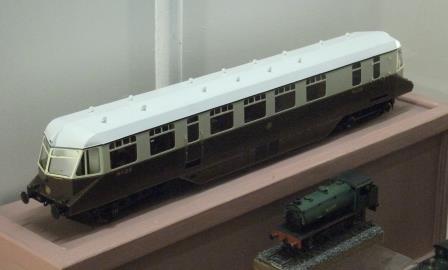
From the 1930s onwards, the Great Western Railway experimented with diesel traction. Its idea of a steam railcar (steam rail motor) was well received by its customers, but was operationally not that successful. Its diesel railcars were much more successful, and indeed, were the forerunners of the diesel multiple units we know and use today. Number 20 was built in 1940 for quieter branch lines and would have been just the concept for the pre-tourist K&ESR. Here, of course, you see a model, but its real life counterpart is being actively restored by K&ESR volunteers. Who knows, one day you might be travelling on it from Robertsbridge to Tenterden Town! Beneath it, hiding somewhat in the shadows on the right, is a model of one of K&ESR's 0-6-0 saddle tanks, perhaps the one which will be pulling my train back to Bodiam today.
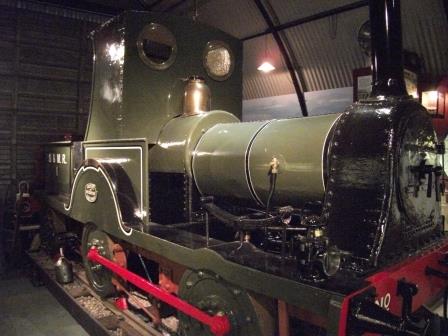
This, it is claimed, is the smallest standard gauge steam locomotive ever built. It was made by Dodman’s of Kings Lynn in 1893, for the private use (!!) of a certain Mr William Burkett; it had wooden wheels and was called "Gazelle".
After Mr Burkett died, Colonel Stephens bought it (in February 1911) for his Shropshire and Montgomeryshire Railway. He had the wheel arrangement changed from 2-2-2 to 0-4-2, and a cab and "tender enclosure" fitted. In this form, and after a varied career, it survived to the present day, to evoke the interest of all who see her.
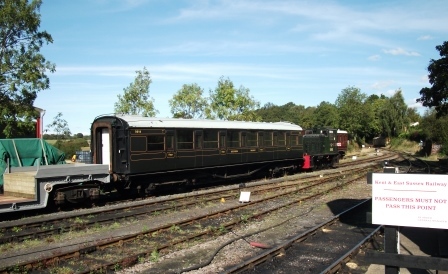
In the sunshine outside, some of the K&ESR's interesting vintage carriages are on display. This one dates from 1931, and is a corridor composite (combined 1st and 3rd class) carriage, designed by Maunsell, of Southern Railway fame.
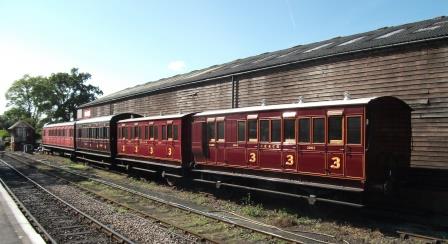
From the station platform, one can see a number of other carriages basking in the sun. Looking from right to left, into the distance, there are two four-wheel 3rd class SECR carriages (1888 and 1901), a four-wheel 3rd class LMS carriage (1911), and, at the far end, an SECR "Birdcage" brake (1910) - the "birdcage" being the raised and glazed section of the roof of the guard's compartment. A nice bit of railway history, in all its painted splendor, brought to life by enthusiastic volunteers.
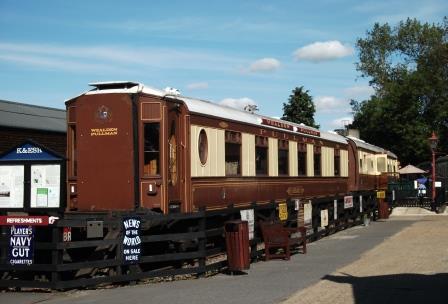
"Barbara" (shown here) together with its sister Pullman car "Theodora" were built in 1926 and form the core of the K&ESR's luxury dining train, the "Wealden Pullman". Another Pullman car, "Aries", may eventually join them. The second coach in this picture (on the right) is a Mark 1 vehicle from the 50s or 60s; it is painted in umber and cream to match, and provides kitchen facilities.

No traditional British Pullman car would be complete without the crests of the Pullman Car Company painted on its side. As you can see here, the Pullman crest shows an assemblage of English, Scottish, Welsh and Irish standards, supported by two serious looking lions.

Tenterden - Town & Church
Tenterden Town is a bustling community which still has strong traces of its distinguished trading past. Its church certainly reflects this and - as expected - contained some interesting monuments reflecting the town's history. I had a short time to catch some glimpses of this before getting the last train back to Bodiam.
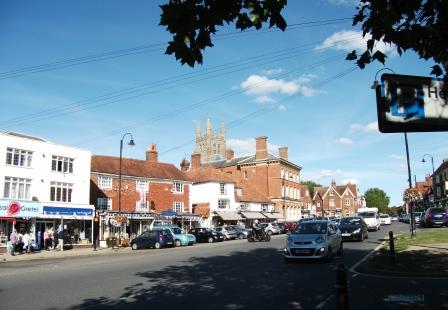
Tenterden benefitted from the 14th century wool trade, and in 1449 the settlement "was incorporated into the Confederation of Cinque Ports as a 'limb of Rye'". Smallhythe, just to the south of Tenterden, originally gave Tenterden access to the sea; apart from wool, Wealden timber also formed an important part of the trade which the port handled.
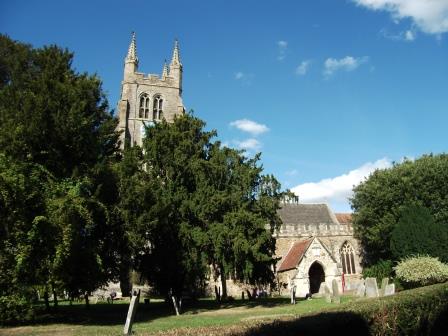
The 12th century St Mildred's church is in the main part of the town, close to Tenterden Town Station.
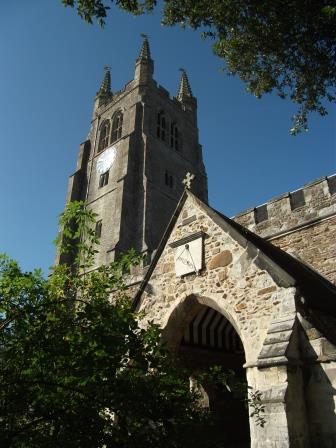
St Mildred's tower was built in 1461, and, in conjunction with other churches, formed part of the 1588 system of warning beacons. Probably it was the French who were the subject of the warnings!

The wooden fan vaulting gracing the church's rood screen is certainly worth seeing.

Tenterden to Bodiam - by Train
Returning by train was not just a question of retracing the journey. One could see things in a different light - or so the saying goes. There were some more aspects of the landscape to be appreciated, and with this, some more photographic opportunities.
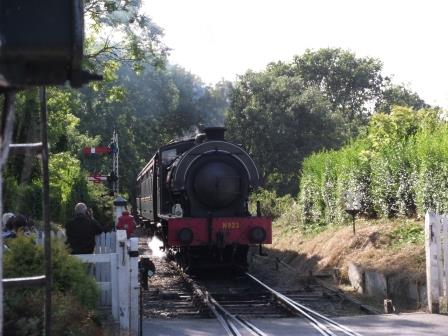
Number 23, "Holman F. Stephens", enters Tenterden Town Station with the train from Bodiam. It will take me back there, for my return walk to Robertsbridge.
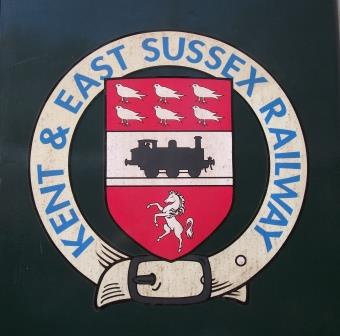
Before I see the engine prepare to run around its train, I manage to get a picture of the K&ESR's crest, adorning one of the Mark 1 carriages of the train. On the crest, an outline of an LBSCR class A1X Terrier sits below the six birds representing East Sussex, and above the White Horse of Kent.

Uncoupling is always done with care. The engine is pointing towards the erstwhile St Michael's halt, but will then reverse ...
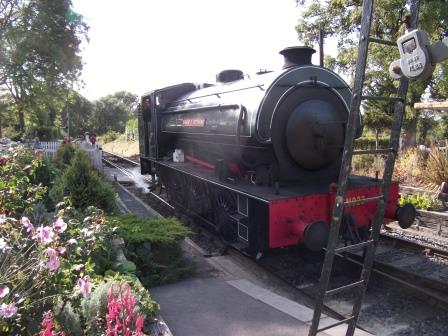
... and be attached to the other end of the last train of the day to Bodiam - the train I need to take to get home!

So we pass the loco shed again. From left to right you can see: "Charwelton (0-6-0ST, 1917), the "GWR" pannier tank (1951) and, on the far right, our old friend "Marcia" (0-4-0T, 1923). A colourful array of branchline motive power.

The train circles around the wide expanse of the Rother valley.

Now its Northiam Station, ...
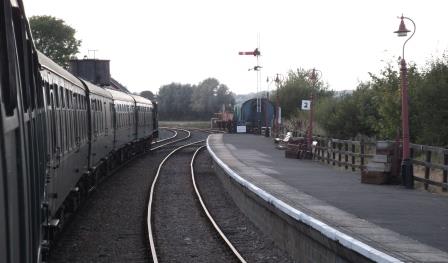
with its curved platforms ...
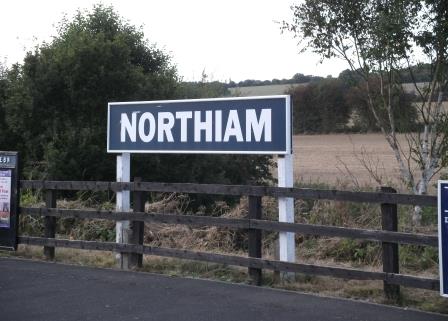
... and its sign clearly and proudly displayed.

Bodiam to Robertsbridge - On Foot
On the return "leg" of my walk I espoused the higher ground. Time constraints meant I had to defer a visit to Bodiam's moated castle to another occasion. However, my route took in a nice converted oast house as well as Salehurst Church with its interesting monuments from the past. One of these monuments related to how the life of the young Princess Victoria may well have been saved in 1832.
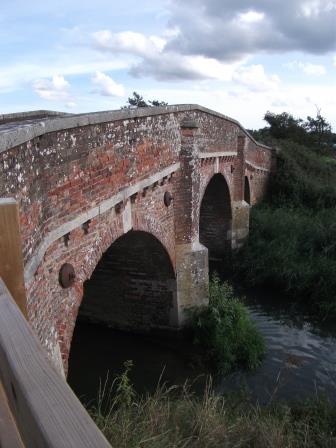
An old humped-back bridge, strenghtened with tie-bars,
links Bodiam Station to the castle and to the village.
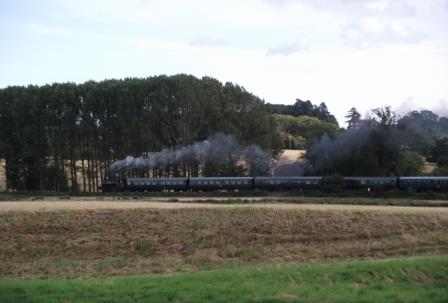
From the castle one can see the last train of the day steaming back to Tenterden Town.
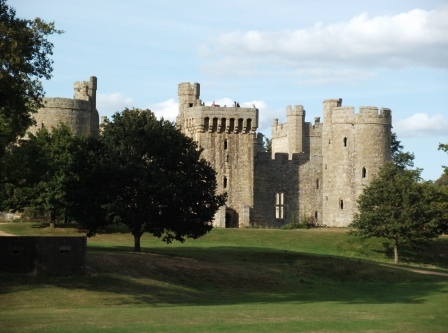
Sir Edward Dalyngrigge built Bodiam Castle in 1385. Probably,the idea was to protect the area against the French in case they wanted to lauch an invasion during the Hundred Years' War. Unfortunately, my tight schedule did not allow me to appreciate the magnificent moated nature of the castle, but perhaps another time.

Nearby a set of oast houses - which may be just outside the Kentish border - look as if they had been converted into an imposing residence. They make a nice picture in the evening sun.
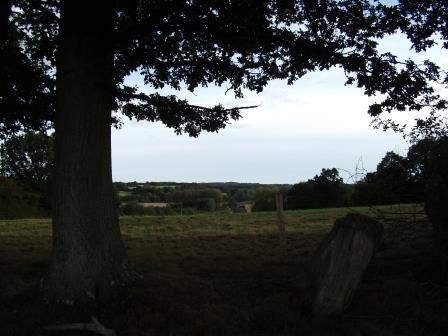
On the way to Salehurst, dusk is fast approaching, casting its cloak over the Weald.

I reach Salehurst's venerable church of St Mary the Virgin before candlelight. The church dates from at least 1640, if not before.
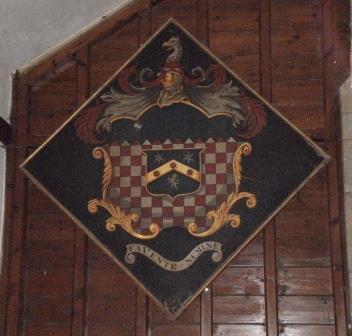
Inside the church there are some interesting monuments from times past. This hatchment appears to be connected with Sir Sotherton Branthwayt Peckham Micklethwait Bart. (1786-1853) of Iridge Place, a little to the north of Salehurst church. He was made a baronet on 27th July 1838 by Queen Victoria. This was as a reward for his quick action in 1832 (or 4th November 1834). The horses of the royal carriage carrying the then Princess Victoria and her mother, the Duchess of Kent, had bolted. One source states that the carriage had actually overturned. Captain Sotherton stood in the way of the horses, and by seizing their bridles, restrained them, and so prevented potential serious injury, or even death, to the two royal occupants of the carriage.
The full Latin inscription reads: "Favente Numine Regina servatur", "By the Grace of God, the Queen was saved". A bit of fascinating history embedded in a church monument!
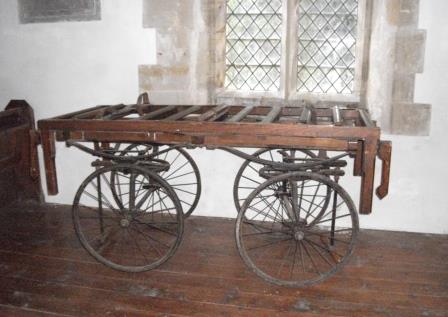
This means of transport is a bit of a mystery. Its wheels appear to be sprung and it appears to have some "fold-out" sections. Perhaps it was intended to transport recumbent people (on mattresses!) or items of a somewhat delicate nature. Who knows? The answer may be hidden in the mists of time! With that unresolved mystery in mind, I rejoin the first part of my walk
With the unresolved mystery of the strange conveyance in Salehurst Church in mind, I cross the path of the - perhaps soon to be reopened - section of the K&ESR, at the spot where the vicar had once arranged for the now long gone halt for one of his flock to be built. Shortly afterwards I rejoin the path to Robertsbridge.

A Poetic Finale
It had been an interesting day, although the journey home was not unduly eventful - after all, night had already fallen. However, if you can make allowances for my amateur approach to the poetic art, I thought I might close with some impromptu verse about the Kent & East Sussex Railway, verse which, in my humble way, tries to draw together some of my experiences of the day.

The Kent and East Sussex Railway (K&ESR) is presently open from Bodiam to Tenterden Town - a distance of about 10.5 miles. A substantial part of the "missing link" between Robertsbridge and Bodiam is already in the hands of the supporting Rother Valley Railway.

A great part of the railway operates close to sea level, following the Rother Valley. Tenterden - the present eastern terminus of the K&ESR - was, after all, associated with the Cinque Ports, indicating that the town originally had close access to the sea.

Distances and heights for the K&ESR. The section between Tenterden and Bodiam is open to visitors and is about 10.5 miles (16.8 Km) in length.
The Walk
The initial idea of the walk was to get to the Kent & East Sussex Railway, which is presently isolated from the rest of the rail network. However, with a circular distance of about nine miles, it was good exercise, both before and after my visit to the heritage railway. Of course, as walks so often do, it also enabled me to appreciate close at hand the countryside in this part of the world.

My "circular" walk of about 9 miles was in the anti-clockwise direction, with of, course a longer stop at Bodiam to explore the Kent & East Sussex Railway. The return "leg" took in Bodiam Castle and Salehurst church.

The land herebouts is, surprisingly, low-level. Heights on my walk ranged from close to sea level to just below 70 metres.

Here are some facts and figures pertaining to my walk. The terrain is not unduly taxing for most walkers, but the landscape is pleasant and interesting.

Robertsbridge to Bodiam - On Foot
My "circular" walk of about 9 miles was in the anti-clockwise direction, with of, course a longer stop at Bodiam to explore the Kent & East Sussex Railway. The start of the walk was of course in Robertsbridge, with its pleasant time-honoured buildings. The outward "leg" of the walk was the more direct part of the walk, passing the site of the old Salehurst Abbey, the site of the old Junction Road Station, and the western-most extremity of the the K&ESR in its present form. The return "leg" took in Bodiam Castle and Salehurst church before rejoining the first part of the walk through Robertsbridge for the final approach to Robertsbridge Station.
Parts of the walk were close to sea level, while the paths kept below 70 metres. Not unduly heavy going for most walkers, leaving time to enjoy the landscape.
Robertsbridge Staion has retained its Victorian splendor. It was the starting point for my visit and might soon be an interchange for the line to Tenterden.
Nearby, the Ostrich pub proudly proclaims its presence with a nicely painted sign and a year that happens to be the year of the "Great Exhibition" in London.
In the centre of Robertsbridge, a half-timbered house nestles comfortably in the greenery.
Closeby, the Robertsbridge village sign stands guard over one end of the high street, ...
... with its traditional buildings.
There is a nice mixture of styles from ages past.
The High Street makes a gentle descent to the north.
On the way to Bodiam, Salehurst comes into view. The fence marks the track of the railway, which, it is hoped will reopen in a few years' time. To the left is the site of the old Salehurst halt; the halt was originally put in at the request of the vicar of Salehurst for one of his flock.
This is at present the western-most limit of the K&ESR track from Tenterden. It is also the site of the old Junction Road Station. The track between here and Bodiam Station actually belongs to the Rother Valley Railway, which is slowly but surely completing the gap between Bodiam and Robertsbridge.

Bodiam to Tenterden - by Train
It was a nice relaxing way to approach Tenterden, allowing me to soak up the wide open expanse of the landscape carved out by the River Rother over millenia, and at the some time, enjoying some railway history from a more recent era. Definitely to be recommended!
I eventually reach Bodiam Station ...
... and I have time to buy by return ticket to Tenterden and generally to have a nose around before the train arrives.
There are some passengers today, but it's a weekday.
The class 33 diesel (vintage 1961) runs around its train ...
... backing on to the other end, ready for the return to Tenterden Town.
As the train heads out of Bodiam Station towards Tenterden Town, the broad-side expanse of the 14th century Bodiam Castle hoves into view. It actually has a sizeable moat, which a closer inspection - on foot - can stunningly reveal.
After Bodiam, comes Northiam and then it's Wittersham Road. The "Road" indicates that the village is a mile or two away from the station.
The train forges on through the Rother Valley, ...
... and then we reach Rolvenden Engine shed.
A signalbox to the south of Rolvenden Station controls the passing loop ...
... and a steam-hauled service is indeed passing, going back towards Bodiam. It hauled by No 23, a 1952 vintage saddle tank.
Outside the engine shed, "Marcia", a diminutive 0-4-0 tank engine of 1923 vintage is being steamed up, perhaps for test purposes.
Rolvenden Station (the original Tenterden Station) has that "built-on-shoe-string" air about it.
Then it's round the curve ...
... into Tenterden Town Station, opened in 1903, three years after Rolvenden Station.
Indeed, the only really substantial brick building on the K&ESR is Tenterden Town Station itself, which houses the head-quarters of the line.

Tenterden - Station & Colonel Stephens Museum
A museum, dedicated to Colonel Stephens, the Victorian and Edwardian promoter of light railways, is housed in a listed corrugated iron building on the north side of Tenterden Station. The museum contains a number of interesting displays and artifacts. Outside, in the station area, some of the K&ESR's collection of splendid vintage and Pullman carriages can be seen.
This is the picnic area to the north of Tenterden Town Station. Tenterden church is in the background. The museum devoted to Colonel Stephens, about whom more below, is in a listed - but not that beautiful - corrugated iron structure, the edge of which you can just discern on the left-hand edge of this picture.
Colonel Holman Fred Stephens (1868 – 1931) was a Light Railway Promoter, Engineer and Manager. Indeed, he had quite a few light railways to his credit, including the Kent & East Sussex Railway and the Ffestiniog Railway. His aim was to bring the railway to those places - such as Tenterden Town - which the big railways had "passed by". Admittedly, most of his enterprises were not blessed with great financial success.
This is a model of "Northiam", built with sister engine "Tenterden" in 1899, ready for the opening in 1900 of the first part of the K&ESR. Both engines were scrapped in 1941, but not before "Northiam" had starred as "Gladstone" in 1937 in Will Hay's "Oh Mr Porter".
From the 1930s onwards, the Great Western Railway experimented with diesel traction. Its idea of a steam railcar (steam rail motor) was well received by its customers, but was operationally not that successful. Its diesel railcars were much more successful, and indeed, were the forerunners of the diesel multiple units we know and use today. Number 20 was built in 1940 for quieter branch lines and would have been just the concept for the pre-tourist K&ESR. Here, of course, you see a model, but its real life counterpart is being actively restored by K&ESR volunteers. Who knows, one day you might be travelling on it from Robertsbridge to Tenterden Town! Beneath it, hiding somewhat in the shadows on the right, is a model of one of K&ESR's 0-6-0 saddle tanks, perhaps the one which will be pulling my train back to Bodiam today.
This, it is claimed, is the smallest standard gauge steam locomotive ever built. It was made by Dodman’s of Kings Lynn in 1893, for the private use (!!) of a certain Mr William Burkett; it had wooden wheels and was called "Gazelle". After Mr Burkett died, Colonel Stephens bought it (in February 1911) for his Shropshire and Montgomeryshire Railway. He had the wheel arrangement changed from 2-2-2 to 0-4-2, and a cab and "tender enclosure" fitted. In this form, and after a varied career, it survived to the present day, to evoke the interest of all who see her.
In the sunshine outside, some of the K&ESR's interesting vintage carriages are on display. This one dates from 1931, and is a corridor composite (combined 1st and 3rd class) carriage, designed by Maunsell, of Southern Railway fame.
From the station platform, one can see a number of other carriages basking in the sun. Looking from right to left, into the distance, there are two four-wheel 3rd class SECR carriages (1888 and 1901), a four-wheel 3rd class LMS carriage (1911), and, at the far end, an SECR "Birdcage" brake (1910) - the "birdcage" being the raised and glazed section of the roof of the guard's compartment. A nice bit of railway history, in all its painted splendor, brought to life by enthusiastic volunteers.
"Barbara" (shown here) together with its sister Pullman car "Theodora" were built in 1926 and form the core of the K&ESR's luxury dining train, the "Wealden Pullman". Another Pullman car, "Aries", may eventually join them. The second coach in this picture (on the right) is a Mark 1 vehicle from the 50s or 60s; it is painted in umber and cream to match, and provides kitchen facilities.
No traditional British Pullman car would be complete without the crests of the Pullman Car Company painted on its side. As you can see here, the Pullman crest shows an assemblage of English, Scottish, Welsh and Irish standards, supported by two serious looking lions.

Tenterden - Town & Church
Tenterden Town is a bustling community which still has strong traces of its distinguished trading past. Its church certainly reflects this and - as expected - contained some interesting monuments reflecting the town's history. I had a short time to catch some glimpses of this before getting the last train back to Bodiam.
Tenterden benefitted from the 14th century wool trade, and in 1449 the settlement "was incorporated into the Confederation of Cinque Ports as a 'limb of Rye'". Smallhythe, just to the south of Tenterden, originally gave Tenterden access to the sea; apart from wool, Wealden timber also formed an important part of the trade which the port handled.
The 12th century St Mildred's church is in the main part of the town, close to Tenterden Town Station.
St Mildred's tower was built in 1461, and, in conjunction with other churches, formed part of the 1588 system of warning beacons. Probably it was the French who were the subject of the warnings!
The wooden fan vaulting gracing the church's rood screen is certainly worth seeing.

Tenterden to Bodiam - by Train
Returning by train was not just a question of retracing the journey. One could see things in a different light - or so the saying goes. There were some more aspects of the landscape to be appreciated, and with this, some more photographic opportunities.
Number 23, "Holman F. Stephens", enters Tenterden Town Station with the train from Bodiam. It will take me back there, for my return walk to Robertsbridge.
Before I see the engine prepare to run around its train, I manage to get a picture of the K&ESR's crest, adorning one of the Mark 1 carriages of the train. On the crest, an outline of an LBSCR class A1X Terrier sits below the six birds representing East Sussex, and above the White Horse of Kent.
Uncoupling is always done with care. The engine is pointing towards the erstwhile St Michael's halt, but will then reverse ...
... and be attached to the other end of the last train of the day to Bodiam - the train I need to take to get home!
So we pass the loco shed again. From left to right you can see: "Charwelton (0-6-0ST, 1917), the "GWR" pannier tank (1951) and, on the far right, our old friend "Marcia" (0-4-0T, 1923). A colourful array of branchline motive power.
The train circles around the wide expanse of the Rother valley.
Now its Northiam Station, ...
with its curved platforms ...
... and its sign clearly and proudly displayed.

Bodiam to Robertsbridge - On Foot
On the return "leg" of my walk I espoused the higher ground. Time constraints meant I had to defer a visit to Bodiam's moated castle to another occasion. However, my route took in a nice converted oast house as well as Salehurst Church with its interesting monuments from the past. One of these monuments related to how the life of the young Princess Victoria may well have been saved in 1832.
An old humped-back bridge, strenghtened with tie-bars,
links Bodiam Station to the castle and to the village.
From the castle one can see the last train of the day steaming back to Tenterden Town.
Sir Edward Dalyngrigge built Bodiam Castle in 1385. Probably,the idea was to protect the area against the French in case they wanted to lauch an invasion during the Hundred Years' War. Unfortunately, my tight schedule did not allow me to appreciate the magnificent moated nature of the castle, but perhaps another time.
Nearby a set of oast houses - which may be just outside the Kentish border - look as if they had been converted into an imposing residence. They make a nice picture in the evening sun.
On the way to Salehurst, dusk is fast approaching, casting its cloak over the Weald.
I reach Salehurst's venerable church of St Mary the Virgin before candlelight. The church dates from at least 1640, if not before.
Inside the church there are some interesting monuments from times past. This hatchment appears to be connected with Sir Sotherton Branthwayt Peckham Micklethwait Bart. (1786-1853) of Iridge Place, a little to the north of Salehurst church. He was made a baronet on 27th July 1838 by Queen Victoria. This was as a reward for his quick action in 1832 (or 4th November 1834). The horses of the royal carriage carrying the then Princess Victoria and her mother, the Duchess of Kent, had bolted. One source states that the carriage had actually overturned. Captain Sotherton stood in the way of the horses, and by seizing their bridles, restrained them, and so prevented potential serious injury, or even death, to the two royal occupants of the carriage. The full Latin inscription reads: "Favente Numine Regina servatur", "By the Grace of God, the Queen was saved". A bit of fascinating history embedded in a church monument!
This means of transport is a bit of a mystery. Its wheels appear to be sprung and it appears to have some "fold-out" sections. Perhaps it was intended to transport recumbent people (on mattresses!) or items of a somewhat delicate nature. Who knows? The answer may be hidden in the mists of time! With that unresolved mystery in mind, I rejoin the first part of my walk
With the unresolved mystery of the strange conveyance in Salehurst Church in mind, I cross the path of the - perhaps soon to be reopened - section of the K&ESR, at the spot where the vicar had once arranged for the now long gone halt for one of his flock to be built. Shortly afterwards I rejoin the path to Robertsbridge.

A Poetic Finale
It had been an interesting day, although the journey home was not unduly eventful - after all, night had already fallen. However, if you can make allowances for my amateur approach to the poetic art, I thought I might close with some impromptu verse about the Kent & East Sussex Railway, verse which, in my humble way, tries to draw together some of my experiences of the day.
|
The Kent and East Sussex is a railway called "light", built on a budget ever so tight. And so through the Weald it proudly wends, its tracks making many sharp bends. It's built by Colonel Stephens's enterprising hand, like a number of small railways in the land. The main lines said "Tenterden is really off-course", and left it to the Colonel to bring the iron horse. In the Fifties, when the car was the "thing", it was thought the railway had had its last fling. In the Seventies, enthusiasts came along and started to sing the reopening song! Now 'tween Tenterden and Bodiam the visitor rides, seeing the delights Rother's Valley provides. Also from Robertsbridge to Bodiam you might soon steam, for this useful link now's more than just a pipe dream. |

Some Links
To whet your appetite, here are some links to further information. These should be useful for your visit. The order of the place links is alphabetic, visiting priorities are your choice! Of course, your search engine will, no doubt, also give you some helpful links.
|
Heritage Railways Kent & East Sussex Railway Rother Valley Railway Colonel Stephens Railway Museum Colonel Stephens Society |
Places of Interest Bodiam Castle Robertsbridge and Salehurst Village Tenterden Town |
